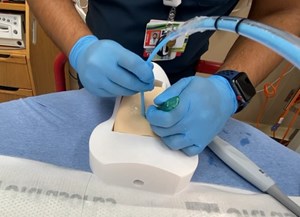
EUS Research Roadmap - Part 1
Research Subcommittee
The Institute of Medicine estimated that 17 years are required to pass before 14% of effective interventions reach the bedside.1 A formal accounting of how the field of Emergency Ultrasound (EUS) (meant to be synonymous with Emergency Medicine Point-of-Care-Ultrasound (EM-POCUS)) has performed is likely coming if we accept that EUS gained broad traction in the early 2000s. Informally, and as members of ACEP’s EUS community for nearly a 17 year time span, it seems like there's more work to be done for educators in EM residency programs. They can shift their training paradigms to learning how to diagnose, manage, and treat primarily through the lens of EUS. We can accept that medicine is a traditionally conservative field slow to change, and slower still, to adapt to new technology. Alternatively, a field demonstrates maturity when it can look inward and find gaps in its evolution. What follows is our opinion on the three primary gaps we observed that, once identified, will hopefully trigger formal action and a call to make our field better through research.
Early-stage researchers focused on agreement, not diagnosis. Seeking acceptance of EUS by other fields resulted in comparison studies demonstrating that, with appropriate training, emergency physicians performed as well as imaging consultants. Perceived “turf wars” persuaded early researchers to perform “me too” studies comparing EUS findings with that of consultants. Some of the earliest publications on biliary ultrasound, deep vein thrombosis, and assessment of left ventricular function reported agreement but not diagnostic accuracy.2-5 The vast majority of benefits were related to Emergency Department (ED) operation metrics (length of stay, waiting times). Future research should focus on accuracy of diagnosis and report agreement as secondary outcomes.
New or “niche” EUS applications focused on diagnosis, but insufficiently on outcomes. Not placing a spotlight on patient centered outcomes, but rather “getting it right” within standard practice of emergency medicine slows wider implementation and dissemination. For example, optic nerve sheath diameter, cardiac assessment, and early pregnancy published diagnostic performance characteristics and ED operations metrics. However, outcomes such as patient mortality, re-admission, cost, patient satisfaction, or fertility outcomes were not reported.6-8 The maturation of the EUS research field was clearly improving in terms of methodology, but a compelling case for uptake by the entire field of Emergency Medicine was missing. This pattern is likely common in a field embracing new technology. Unfortunately, under-reporting of outcomes is unlikely to motivate “late adopters” to seek education and part with their current practice patterns. Future studies should address patient outcomes primarily so physicians who use EUS can make a more compelling case to stakeholders, such as providers not yet invested in POCUS, patients, and payers.
Lastly, most of the EUS research occurred in academic settings and not in non-academic community practice, which represents the majority of patients seen worldwide. This threatens external validity of findings. These trends have bottled up much of the gains enjoyed by many physicians who routinely apply high level ultrasound applications to their practice. To have a meaningful impact on patient care, it is crucial to integrate POCUS into clinical practice outside of academic medical centers. Healthcare providers practicing in the non-academic settings may not even be familiar with current evidence, recent technological advancements, ever-lowering cost, and ease of use. Well-designed strategies to facilitate the dissemination of research evidence to community clinical settings are crucial to make a bigger impact on patient outcomes and costs. Future protocols should focus exclusively on community sites or seek to integrate the academic and community site experience. This area is ripe for dissemination and implementation studies.
Despite these gaps there are bright spots. Significant research exists to justify that outcomes of procedures improve when assisted by EUS. These studies succeed because investigators examined downstream outcomes likely to happen in the emergency department. The incidence of the procedure and outcome was sufficiently high to efficiently recruit cases in a short amount of time. EUS’s record in patient safety research is worthy of more intense study focusing on short- and long-term patient outcomes.9-12 Another area where EUS has proven superior to any modality is the quick identification of hemorrhagic shock. In fact, it can be argued that no imaging modality is as useful. The first sonography outcomes assessment program trial (SOAP-1) by Melniker et. al. demonstrated decreased length of stays, decreased costs, and decreased radiation in trauma patients with a high probability of hemorrhagic shock.13 Sixteen years later, the FAST has gained acceptance and is taught in residency curriculum and is part of ATLS. However, methodological flaws in attempts to unsuccessfully recreate these benefits in Pediatrics has revealed more about physician imaging preferences and strong biases than on the utility of ultrasound technology.14 The degree of implementation of the FAST is poorly understood. Blame can be laid at funding agencies and the adoption of CT imaging amongst Trauma Surgeons. However, as a field, we should own the responsibility to further justify integration of ultrasound in cases of suspected hemorrhagic shock.
Artificial intelligence is rapidly making an impact on medical imaging and several studies of deep learning applications in POCUS will soon be emerging as well. Ultrasound, in particular, may benefit from the use of artificial intelligence. Deep learning is a state-of-the-art machine-learning technique that has proven excellent at pattern recognition in images but has not yet been extensively applied to point-of-care ultrasound. Preliminary research suggests that automated tools increase efficiency and confidence of the operators. By integrating artificial intelligence-assisted image acquisition and analysis with ultrasound technology, it may be possible for minimally trained operators in resource-limited settings to use POCUS. These algorithms can mitigate challenges with training and expertise by providing inexperienced users with reliable automated tools. As artificial intelligence tools for handheld ultrasound devices become available, a second opportunity to justify a heavier reliance on EUS exists.
There are numerous EUS studies of enormous importance and impact. The perception of EUS as an important body of knowledge that aids patient care is beginning to solidify. The breadth of applications continues to grow but, like all great ideas, the field could use more focus on its gains than new and interesting ways to possibly help physicians. Twenty-six years ago, one of the earliest published papers reported the benefits of ultrasound in trauma, aortic syndromes, pelvic pathologies, and other applications. Interestingly the same paper, written by the pioneers James Mateer and Dietrich Jehle, outlined research priorities that included defining training criteria, establishing the cost effectiveness of applications, and identifying ultrasound uses that improved patient outcomes.15 With adopted ultrasound training curricula, they argued, emergency medicine residency graduates would prove to be the “wave of the future.” We should heed the call of our earliest adopters and compel our colleagues to use ultrasound not because of its novelty, but because our patients do better when we scan them! The future is here.
References
- Carpenter CR, Pinnock H. Starry Aims to Overcome Knowledge Translation Inertia: The Standards for Reporting Implementation Studies (StaRI) Guidelines. Acad Emerg Med. 2017;24(8):1027-1029. https://onlinelibrary.wiley.com/doi/abs/10.1111/acem.13235
- Blaivas M, Harwood RA, Lambert MJ. Decreasing length of stay with emergency ultrasound examination of the gallbladder. Acad Emerg Med. 1999;6(10):1020-1023. http://www.ncbi.nlm.nih.gov/entrez/query.fcgi?cmd=Retrieve&db=PubMed&dopt=Citation&list_uids=10530660
- Jang T, Docherty M, Aubin C, et al. Resident-performed compression ultrasonography for the detection of proximal deep vein thrombosis: fast and accurate. Acad Emerg Med. 2004;11(3):319-22. https://www.ncbi.nlm.nih.gov/pubmed/15001419
- Theodoro D, Blaivas M, Duggal S, et al. Real-time B-mode ultrasound in the ED saves time in the diagnosis of deep vein thrombosis (DVT). Am J Emerg Med. 2004;22(3):197-200. http://www.ncbi.nlm.nih.gov/pubmed/15138956
- Moore CL, Rose GA, Tayal VS, et al. Determination of left ventricular function by emergency physician echocardiography of hypotensive patients. Acad Emerg Med. 2002;9(3):186-93. http://onlinelibrary.wiley.com/store/10.1197/aemj.9.3.186/asset/aemj.9.3.186.pdf?v=1&t=i2p0rroa&s=aa08bad385ea71418840401210f32bddacb28cc9
- Tayal VS, Neulander M, Norton HJ, et al. Emergency department sonographic measurement of optic nerve sheath diameter to detect findings of increased intracranial pressure in adult head injury patients. Ann Emerg Med. 2007;49(4):508-14. http://www.ncbi.nlm.nih.gov/entrez/query.fcgi?cmd=Retrieve&db=PubMed&dopt=Citation&list_uids=16997419
- Tayal VS, Cohen H, Norton HJ. Outcome of patients with an indeterminate emergency department first-trimester pelvic ultrasound to rule out ectopic pregnancy. Acad Emerg Med. 2004;11(9):912-7. http://www.ncbi.nlm.nih.gov/pubmed/15347539
- Weekes AJ, Tassone HM, Babcock A, et al. Comparison of serial qualitative and quantitative assessments of caval index and left ventricular systolic function during early fluid resuscitation of hypotensive emergency department patients. Acad Emerg Med. 2011;18(9):912-21. https://onlinelibrary.wiley.com/doi/full/10.1111/j.1553-2712.2011.01157.x
- Leung J, Duffy M, Finckh A. Real-time ultrasonographically-guided internal jugular vein catheterization in the emergency department increases success rates and reduces complications: A randomized, prospective study. Ann Emerg Med. 2006;48(5):540-7. http://www.sciencedirect.com/science/article/B6WB0-4J9VMP0-2/2/4bcdca029f80b2a42e989b8a104d2a07
- Milling T, Holden C, Melniker L, et al. Randomized controlled trial of single-operator vs. two-operator ultrasound guidance for internal jugular central venous cannulation. Acad Emerg Med. 2006;13(3):245-7.
- Nazeer SR, Dewbre H, Miller AH. Ultrasound-assisted paracentesis performed by emergency physicians vs the traditional technique: a prospective, randomized study. Am J Emerg Med. 2005;23(3):363-7.
- Hibbert RM, Atwell TD, Lekah A, et al. Safety of ultrasound-guided thoracentesis in patients with abnormal preprocedural coagulation parameters. 2013;144(2):456-63.
- Melniker LA, Leibner E, McKenney MG, et al. Randomized controlled clinical trial of point-of-care, limited ultrasonography for trauma in the emergency department: the first sonography outcomes assessment program trial. Ann Emerg Med. 2006;48(3):227-35. http://www.ncbi.nlm.nih.gov/entrez/query.fcgi?cmd=Retrieve&db=PubMed&dopt=Citation&list_uids=16934640
- Holmes JF, Kelley KM, Wootton-Gorges SL, et al. Effect of abdominal ultrasound on clinical care, outcomes, and resource use among children with blunt torso trauma: A randomized clinical trial. 2017;317(22):2290-6.http://dx.doi.org/10.1001/jama.2017.6322
- Mateer JR, Jehle D. Ultrasonography in emergency medicine. Acad Emerg Med. 1994;1(2):149-152. http://www.ncbi.nlm.nih.gov/entrez/query.fcgi?cmd=Retrieve&db=PubMed&dopt=Citation&list_uids=7621172
Daniel Theodoro MD, FACEP
Chief EM Point-of-care Ultrasound Washington University
Srikar Adhikari, MD
Section Chief, Emergency Ultrasound



